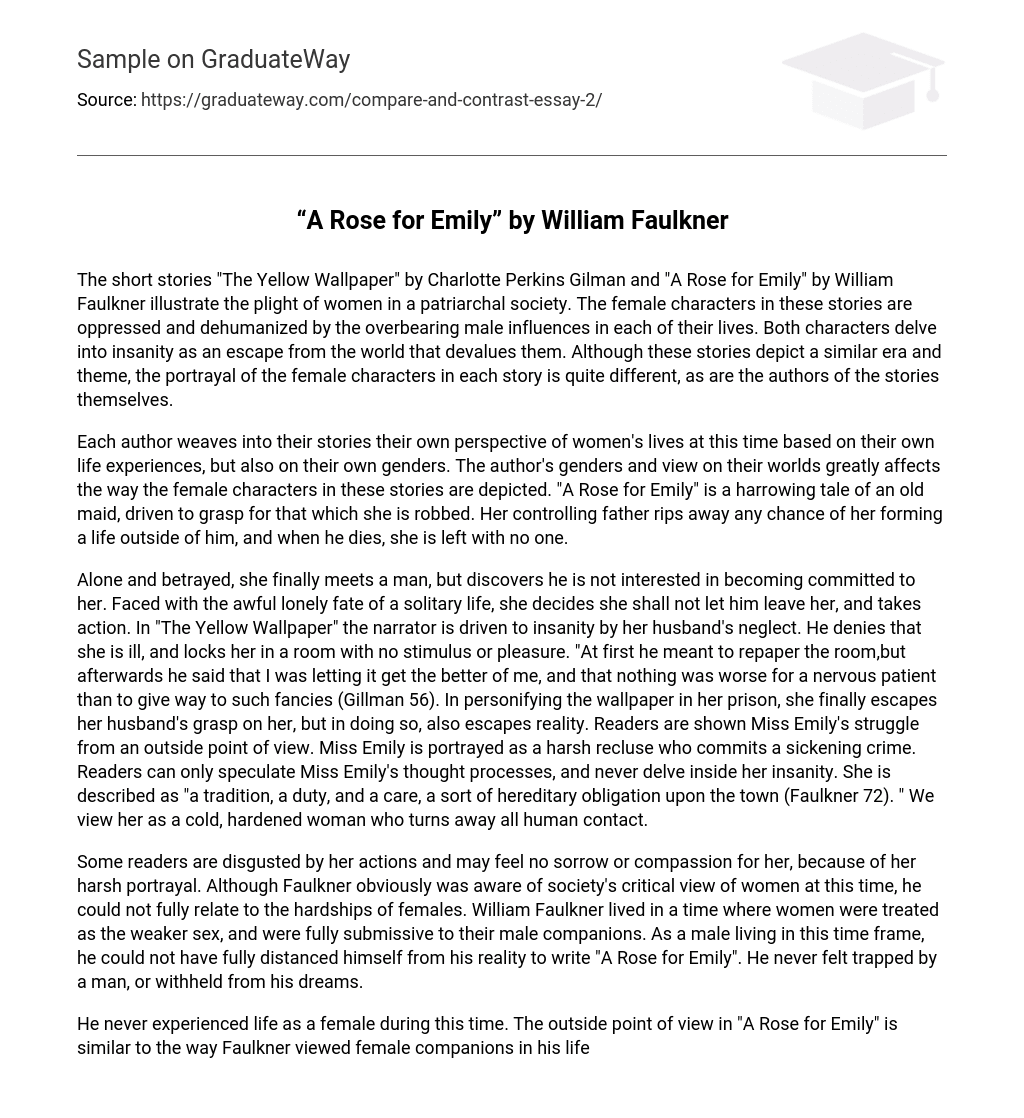The short stories “The Yellow Wallpaper” by Charlotte Perkins Gilman and “A Rose for Emily” by William Faulkner illustrate the plight of women in a patriarchal society. The female characters in these stories are oppressed and dehumanized by the overbearing male influences in each of their lives. Both characters delve into insanity as an escape from the world that devalues them. Although these stories depict a similar era and theme, the portrayal of the female characters in each story is quite different, as are the authors of the stories themselves.
Each author weaves into their stories their own perspective of women’s lives at this time based on their own life experiences, but also on their own genders. The author’s genders and view on their worlds greatly affects the way the female characters in these stories are depicted. “A Rose for Emily” is a harrowing tale of an old maid, driven to grasp for that which she is robbed. Her controlling father rips away any chance of her forming a life outside of him, and when he dies, she is left with no one.
Alone and betrayed, she finally meets a man, but discovers he is not interested in becoming committed to her. Faced with the awful lonely fate of a solitary life, she decides she shall not let him leave her, and takes action. In “The Yellow Wallpaper” the narrator is driven to insanity by her husband’s neglect. He denies that she is ill, and locks her in a room with no stimulus or pleasure. “At first he meant to repaper the room,but afterwards he said that I was letting it get the better of me, and that nothing was worse for a nervous patient than to give way to such fancies (Gillman 56).
In personifying the wallpaper in her prison, she finally escapes her husband’s grasp on her, but in doing so, also escapes reality. Readers are shown Miss Emily’s struggle from an outside point of view. Miss Emily is portrayed as a harsh recluse who commits a sickening crime. Readers can only speculate Miss Emily’s thought processes, and never delve inside her insanity. She is described as “a tradition, a duty, and a care, a sort of hereditary obligation upon the town (Faulkner 72). ” We view her as a cold, hardened woman who turns away all human contact.
Some readers are disgusted by her actions and may feel no sorrow or compassion for her, because of her harsh portrayal. Although Faulkner obviously was aware of society’s critical view of women at this time, he could not fully relate to the hardships of females. William Faulkner lived in a time where women were treated as the weaker sex, and were fully submissive to their male companions. As a male living in this time frame, he could not have fully distanced himself from his reality to write “A Rose for Emily”. He never felt trapped by a man, or withheld from his dreams.
He never experienced life as a female during this time. The outside point of view in “A Rose for Emily” is similar to the way Faulkner viewed female companions in his life. As a male, he too was an outsider to the female mind and could only imagine the thoughts of the women around him. “The Yellow Wallpaper” is viewed from the female characters point of view. Readers are aware of her thoughts, hopes and dreams, and we are guided down her road to insanity. We are able to view her thought process as she abandons reality in the hopes of achieving freedom.
The narrator is portrayed as an ill woman who is denied help and abandoned. Readers are able to view her hurt and desperation and connect with her in a way we could not with Miss Emily. We can envision her journey through mental illness, and are able to empathize with her. It is no surprise ” The Yellow Wallpaper” was written by a woman. She lived each day with the struggle of being a woman in this era.
Charlotte Perkins Gilman faced a similar reality to the female character in “The Yellow Wallpaper”, and therefore brings the reader to understand the female’s point of view through her own inner turmoil. I cry at nothing, and cry most of the time. Of course I don’t when John is here, or anybody else, but when I am alone (Gilman 59). ” We feel sorrow for this woman, and can understand the nature of her illness. Readers can relate to the narrator, and feel empathy for her.
The way the short stories “The Yellow Wallpaper” and “A Rose for Emily” are written are greatly dependent on their author’s genders. Perhaps if the author of “A Rose for Emily” were a woman, we would be able to connect with Miss Emily, and envision her pain on a deeper level. We would perhaps have a greater understanding of her mind and the thoughts that led her to her crime and may have been portrayed as a desperate, isolated woman who committed a crime out of loneliness.
If the author of “The Yellow Wallpaper” were a man, perhaps John would be portrayed as a heroic husband who sacrificed for his ill wife. Perhaps the narrator would be portrayed as a burden on her caring husband, causing him much grief and many tears. Although these stories tell of two desperate women, the point of view from which they are told, and the author’s insights greatly affect the way these characters are depicted.





